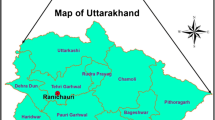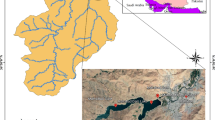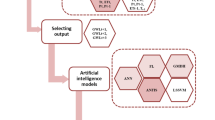Abstract
Evaporation, a major component of hydrologic cycle, is an important parameter to many applications in water resource management, irrigation scheduling, and environmental studies. In this study, two soft computing techniques: (a) Artificial Neural Network (ANN), (b) Co-active Neuro-Fuzzy Inference System (CANFIS); and Multiple Linear Regression (MLR) were used to simulate daily pan evaporation (Ep) at Pantnagar, located at the foothills of Himalayas in the Uttarakhand state of India. Daily meteorological data such as maximum and minimum air temperature, relative humidity in the morning (7 AM) and afternoon (2 PM), wind speed, sun shine hours and pan evaporation form January 1, 2001 to December 31, 2004 were used for developing the ANN, CANFIS and MLR models. A comparison based on statistical indices such as root mean squared error (RMSE), coefficient of efficiency (CE) and correlation coefficient (r) was made among the estimated magnitudes of Ep by the ANN, CANFIS and the MLR models. The architecture of ANN and CANFIS were managed by NeuroSolutions 5.0 software produced by NeuroDimension, Inc., Florida. The architecture of ANN was designed with hyperbolic tangent activation function and Delta-Bar-Delta learning algorithm and similarly the architecture of CANFIS was designed with Gaussian membership function, Takagi-Sugeno-Kang fuzzy model, hyperbolic tangent activation function and Delta-Bar-Delta learning algorithm. The results indicated that the performance of ANN model with 6-9-1 architecture in general was superior to the CANFIS and MLR models; however, the performance of CANFIS models was better than MLR models. The ANN model with all input variables and single hidden layer was found to be the best in simulating Ep at Pantnagar.






Similar content being viewed by others
References
Aytek A (2008) Co-active neuro fuzzy inference system for evapotranspiration modelling. Soft Comput 13(7):691–700
Bruton JM, Mcclendon RW, Hoogenboom G (2000) Estimating daily pan evaporation with artificial neural networks. Trans ASAE 43(2):491–496
Burman RD (1976) Intercontinental comparison of evaporation estimates. J Irrig Drain Eng ASCE 102:109–118
Chu TW, Shirmohammadi A (2004) Evaluation of the SWAT model’s hydrology component in the piedmont physiographic region of Maryland. Trans ASAE 47(4):1057–1073
Coulomb CV, Legesse D, Gasse F, Travi Y, Chernet T (2001) Lake evaporation estimates in tropical Africa (Lake Ziway, Ethiopia). J Hydrol 245:1–18
Dawson CW, Abrahart RJ, Shamseldin AY, Wilby RL (2006) Flood estimation at ungauged sites using artificial neural networks. J Hydrol 319:391–409
Deswal S, Pal M (2008) Artificial neural network based modeling of evaporation losses in reservoirs. Proc World Acad Sci Eng Tech 29:279–283
Dinpashoh Y (2006) Study of reference crop evapotranspiration in I.R of Iran. Agric Water Manag 84:123–129
Eslamian SS, Gohari SA, Biabanaki M, Malekian R (2008) Estimation of monthly pan evaporation using artificial neural networks and support vector machines. J Appl Sci 8(19):3497–3502
Frevert DK, Hill RW, Braaten BC (1983) Estimation of FAO evapotranspiration coefficients. J Irrig Drain Eng ASCE 109(2):265–270
Gavin H, Agnew CA (2004) Modelling actual, reference and equilibrium evaporation from a temperate wet grassland. Hydrol Process 18:229–246
Googhari SK (2012) Daily pan evaporation estimation using a neuro-fuzzy-based model. J Agric Sci Tech 2:223–228
Haciismailoglu MC, Kucuk I, Derebasi N (2009) Prediction of dynamic hysteresis loops of nano-crystalline cores. Expert Syst Appl 36:2225–2227
Heydari M, Talaee PH (2011) Prediction of flow through rockfill dams using a neuro-fuzzy computing technique. J Math Comput Sci 2(3):515–528
Irmak S, Haman D, Jones JW (2002) Evaluation of class A pan coefficients for estimating reference evapotranspiration in a humid location. J Irrig Drain Eng ASCE 128(3):153–159
Ishak S, Trifiro F (2007) Neural networks, transportation research circular EC113. Artif Intell Transp 17–32
Jang JSR, Sun CT, Mizutani E (1997) Neuro fuzzy and soft computing: a computational approach to learning and machine intelligence. Prentice-Hall, NJ, p 607
Jensen ME (1974) Consumptive use of Water and Irrigation Requirements. Report by the Technical Committee of the Irrigation Water Requirements of the Irrig Drain Division, ASCE, New York
Keskin ME, Terzi O (2006) Artificial neural network models of daily pan evaporation. J Hydrol Eng 11(1):65–70
Keskin ME, Terzi O, Taylan D (2004) Fuzzy logic model approaches to daily pan evaporation estimation in Western Turkey. Hydrol Sci J 49(6):1001–1010
Khanikar PG, Nath KK (1998) Relationship of open pan evaporation rate with some important meteorological parameters. J Agric Sci Soc 11(1):46–50
Kim S, Kim HS (2008) Neural networks and genetic algorithm approach for nonlinear evaporation and evapotranspiration modeling. J Hydrol 351:299–317
Kisi O (2006) Daily pan evaporation modeling using a neuro-fuzzy computing technique. J Hydrol 329:636–646
Kisi O (2009) Modeling monthly evaporation using two different neural computing techniques. Irrig Sci 27:417–430
Kumar M, Raghuvanshi NS, Singh R, Wallender WW, Pruitt WO (2002) Estimating evapotranspiration using artificial neural network. J Irrig Drain Eng ASCE 128(4):224–233
Lenters JD, Kratz TK, Bowser CJ (2005) Effects of climate variability on lake evaporation: results from a long-term energy budget study of Sparkling Lake, Northern Wisconsin (USA). J Hydrol 308:168–195
Linarce ET (1967) Climate and the evaporation from crops. J Irrig Drain Eng ASCE 93:61–79
Lippman R (1987) An introduction to computing with neural nets. IEEE ASSP Mag 4:4–22
Lohani AK, Goel NK, Bhatia KKS (2007) Deriving stage–discharge–sediment concentration relationships using fuzzy logic. Hydrol Sci J 52(4):793–807
Marofi S, Tabari H, Zare AH (2011) Predicting spatial distribution of snow water equivalent using multivariate nonlinear regression and computational intelligence methods. Water Resour Manag 25(5):1417–1435
Nash JE, Sutcliffe JV (1970) River flow forecasting through conceptual models: part 1. A discussion of principles. J Hydrol 10(3):282–290
Ozbayoglu G, Ozbayoglu ME (2006) A new approach for the prediction of ash fusion temperatures: a case study using Turkish lignites. Fuel 85:545–552
Ozlem T, Evolkesk M (2005) Modeling of daily pan evaporation. J Appl Sci 5(2):368–372
Rahimikhoob A (2009) Estimating daily pan evaporation using artificial neural network in a semi-arid environment. Theor Appl Climatol 98(1–2):101–105
Reis RJ, Dias NL (1998) Multi-season lake evaporation: energy-budget estimates and CRLE model assessment with limited meteorological observations. J Hydrol 208:135–147
Rumelhart DE, Hinton GE, Williams RJ (1986) Learning internal representation by error propagation. In: Rumelhart DE, McClelland JL (eds) Parallel distributed processing foundations, vol. 1. MIT Press, Cambridge
Sabziparvar AA, Tabari H (2010) Comparison of artificial neural network models and non-linear regression methods for estimation of potato crop evapotranspiration in a semi-arid region of Iran. The International Conference on Intelligent Network and Computing, November 26–28, Kuala Lumpur, Malaysia
Sabziparvar AA, Tabari H, Aeini A, Ghafouri M (2010) Evaluation of class A pan coefficient models for estimation of reference crop evapotranspiration in cold-semi arid and warm arid climates. Water Resour Manag 24(5):909–920
Saemi M, Ahmadi M (2008) Integration of genetic algorithm and a coactive neuro-fuzzy inference system for permeability prediction from well logs data. Transp Porous Media 71:273–288
Shirgure PS (2011) Evaporation modeling with neural networks-A research review. Int J Res Rev Soft Intell Comput 1(2):37–47
Shirgure PS, Rajput GS (2012) Prediction of daily pan evaporation using neural networks models. Sci J Agric 1(5):126–137
Shirsath PB, Singh AK (2010) A comparative study of daily pan evaporation estimation using ANN, regression and climate based models. Water Resour Manag 24:1571–1581
Shrivastava SK, Sahu AK, Dewangan KN, Mishra SK, Upadhyay AP, Dubey AK (2001) Estimating pan evaporation from meteorological data for Jabalpur. Indian J Soil Cons 29(3):224–228
Singh R, Prakash O, Khicher ML, Singh R, Prakash O (1995) Estimation of evaporation from different meteorological parameters. Ann Arid-Zone 34(4):63–265
Snyder RL (1993) Equation for evaporation pan to evapotranspiration conversions. J Irrig Drain Eng ASCE 118(6):977–980
Stephens JC, Stewart EH (1963) A comparison of procedures for computing evaporation and evapotranspiration. Publication 62, International Association of Scientific Hydrology. International Union of Geodynamics and Geophysics, Berkeley, pp 123–133
Sudheer KP, Gosain AK, Rangan D, Saheb SM (2002) Modeling evaporation using an artificial neural network algorithm. Hydrol Process 16:3189–3202
Sudheer KP, Gosain AK, Ramasastri KS (2003) Estimating actual evapotranspiration from limited climate data using neural computing technique. J Irrig Drain Eng ASCE 129(3):214–218
Tabari H, Marofi S, Sabziparvar AA (2010) Estimation of daily pan evaporation using artificial neural network and multivariate nonlinear regression. Irrig Sci 28:399–406
Tabari H, Sabziparvar AA, Ahmadi M (2011) Comparison of artificial neural network and multivariate linear regression methods for estimation of daily soil temperature in an arid region. Meteorog Atmos Phys 110:135–142
Tabari H, Talaee PH, Abghari H (2012) Utility of coactive neuro-fuzzy inference system for pan evaporation modeling in comparison with multilayer perceptron. Meteorol Atmos Phys 116:147–154
Takagi T, Sugeno M (1985) Fuzzy identification of systems and its application to modeling and control. IEEE Trans Syst Manag Cybern 15(1):116–132
Terzi O, Keskin ME (2005) Modelling of daily pan evaporation. J Appl Sci 5(2):368–372
Torres M, Hervas C, Amador F (2005) Approximating the sheep milk production curve through the use of artificial neural networks and genetic algorithms. Comput Oper Res 32:2653–2670
Trajkovic S, Todorovic B, Stankovic M (2003) Forecasting of reference evapotranspiration by artificial neural network. J Irrig Drain Eng ASCE 129(6):454–457
Vining KC (2003) Estimation of monthly evaporation from Lake Ashtabulain North Dakota, Orwell Lake in Minnesota, and LakeTraverse in Minnesota and South Dakota, 1931–2001. Water-Resources Investigations Report, US Department of the Interior, US Geological Survey
Xing-Jie JI, Ji-Jun W, Wan-Long GU, Ye-Yu Z, Feng-Xiu LI (2010) Trends in annual and seasonal pan evaporation in the Lower Yellow River Basin from 1961 to 2010. Adv Clim Change Res 3(4):195–204
Yuhe J, Guangsheng Z (2011) Important factors governing the incompatible trends of annual pan evaporation, evidence from a small scale region. Clim Chang 106:303–314
Author information
Authors and Affiliations
Corresponding author
Rights and permissions
About this article
Cite this article
Malik, A., Kumar, A. Pan Evaporation Simulation Based on Daily Meteorological Data Using Soft Computing Techniques and Multiple Linear Regression. Water Resour Manage 29, 1859–1872 (2015). https://doi.org/10.1007/s11269-015-0915-0
Received:
Accepted:
Published:
Issue Date:
DOI: https://doi.org/10.1007/s11269-015-0915-0




